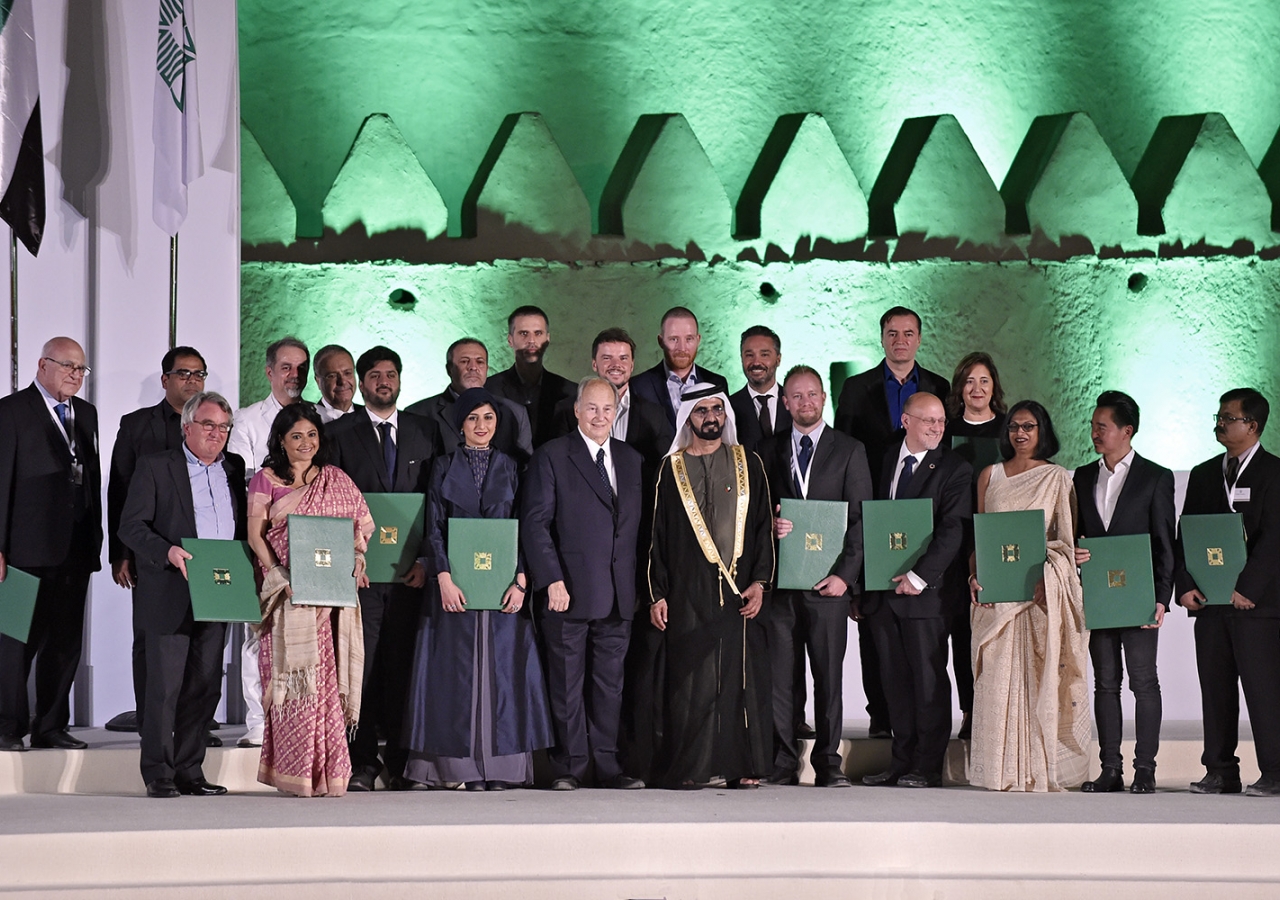Al Ain, UAE, 6 November 2016 — Architecture does not merely give form to the spaces in which we live and move, it profoundly shapes and can improve the quality of human life. The winning projects in the 13th cycle of the Aga Khan Award for Architecture testify to this.
» AKDN coverage, speech, press release
» Aga Khan Award for Architecture announces winning projects for 2016
» Hanif Kara on four decades of the Award
“Architecture is the only art form which has a direct, daily impact on the quality of human life,” remarked Mawlana Hazar Imam, who is the Chairman of the Award’s Steering Committee. The 2016 Award Ceremony was held at the Al Jahili Fort, a World Heritage Site in Al Ain, in the Emirate of Abu Dhabi.
His Highness Sheikh Mohammed bin Rashid Al Maktoum, Vice President and Prime Minister of the United Arab Emirates, and Ruler of Dubai was the Chief Guest at the ceremony, which was attended by several prominent members of the nation’s ruling families. Prince Amyn, Prince Hussain and Prince Aly Muhammad accompanied Mawlana Hazar Imam.
Six winning projects were honoured in the ceremony. They are marked as much by the contrasts between them as by their determination to challenge norms in the contexts in which they were built.
There is the pedestrian bridge in Tehran that isn’t satisfied with conveying people from point A to point B, but has rather become a plural space of gathering unto itself. And in Copenhagen, a whimsical park that creates a safe space for a socially challenged neighbourhood of recent immigrants, all the while connecting with their 62 countries of origin through objects imported from their homelands.
Literally carving itself from the earth as a defence against the floods and earthquakes that afflict rural Bangladesh, the pavilions, pools and courtyards of the Friendship community centre echo the ruins of the country's earliest urban archaeological ruin. Meanwhile, knitted into the dense urban fabric of Beijing, a vibrant children’s library and art centre grew around a tree within a 300 – 400-year-old courtyard that once housed a temple, later converted into residences.
A forward-looking building at the American University of Beirut audaciously breaks with the campus’ conventional aesthetic, while standing sentinel to the memory and determination of its late architect. Finally, a mosque in Dhaka sheds the traditional vernacular of dome and minaret, adorning itself in the simplicity of dappled light to breath graceful elegance into a space for prayer and community gathering.
“The six architectural projects we celebrate this evening reaffirm the Award’s founding principles, even as they help us project those principles into the programme’s fifth decade,” said Mawlana Hazar Imam.
The Aga Khan Award for Architecture is one of the oldest and most prestigious awards in architecture. It was established by Mawlana Hazar Imam in 1977 to identify and encourage building concepts that successfully address the needs and aspirations of communities in which Muslims have a significant presence.
The Award has forged past its earliest purpose — of helping to rescue the rich heritage of Islamic architecture that was under threat in the 1970s of being swept away by the press of western modernity and values. It now looks ahead with a “thoughtful concern for the built environment” that Hazar Imam said “can characterise an entire civilisation.”
He described four qualities that the Aga Khan Award aims to promote. First, the idea that architecture does not need to choose between past and future — between “inherited tradition and changing needs.” They complement one another, said Mawlana Hazar Imam: “We can look boldly ahead without ignoring what has gone before.”
The second is found in architecture that helps humanity to live in harmony with nature. “The best architecture teaches us to engage with nature respectfully; not by conquering or subduing it, nor by isolating ourselves away from it,” said Hazar Imam.
“Adaptation to unprecedented challenges” is the third quality that Mawlana Hazar Imam discussed. The rapid pace of technological change has spawned significant new challenges, he said, from climate change to “dangerous threats [that] can circulate more widely and quickly: weapons and pollution, drugs and crime, disease and terrorism, poverty and violence.”
“One result has been an unprecedented increase in the migration of displaced peoples,” observed Hazar Imam. Another, is the deteriorating sense of discipline and personal responsibility, particularly as individuals feel more detached from communities.
“All of these realities – technological, economic, social and ethical – present important challenges for responsible architecture,” said Mawlana Hazar Imam. “The projects we honour tonight have addressed such challenges, each engaging with the particular demands of its own time and place, while expressing the important values of cultural continuity.”
Finally, Mawlana Hazar Imam noted that architecture can embrace difference and diversity, “honouring cultural differences as the valued legacies of our predecessors.”
“The spirit of pluralism has been central to the great achievements of past Islamic cultures, and it remains a central principle for these Awards,” he said. “Great architecture can remind us that pluralism begins with difference, and that it does not require us to leave behind our cherished identities.”
Looking back on the range of projects that the Award has recognised over the years — “from skyscrapers to mud huts, from residences to work and gathering spaces, from reforestation and financing projects to cemeteries, bridges and parks” — Mawlana Hazar Imam observed that “this pluralistic approach may not echo the usual definition of the word ‘architecture’, but it is the closest we can get to the central inclusive message we want this Award to convey.”
“We hope that the Aga Khan Award for Architecture will always point towards an architecture of optimism and harmony, a powerful force in elevating the quality of human life.”







